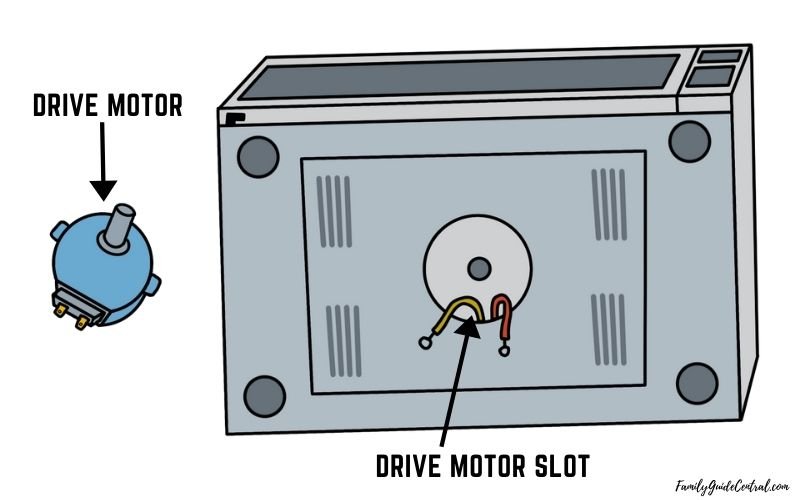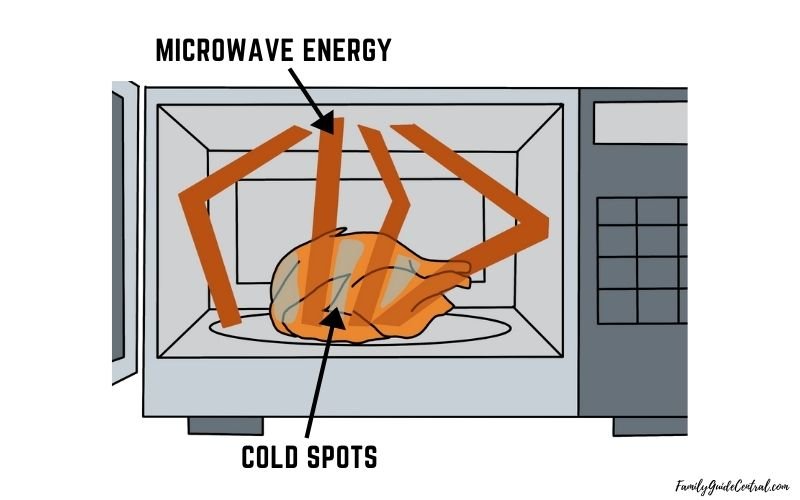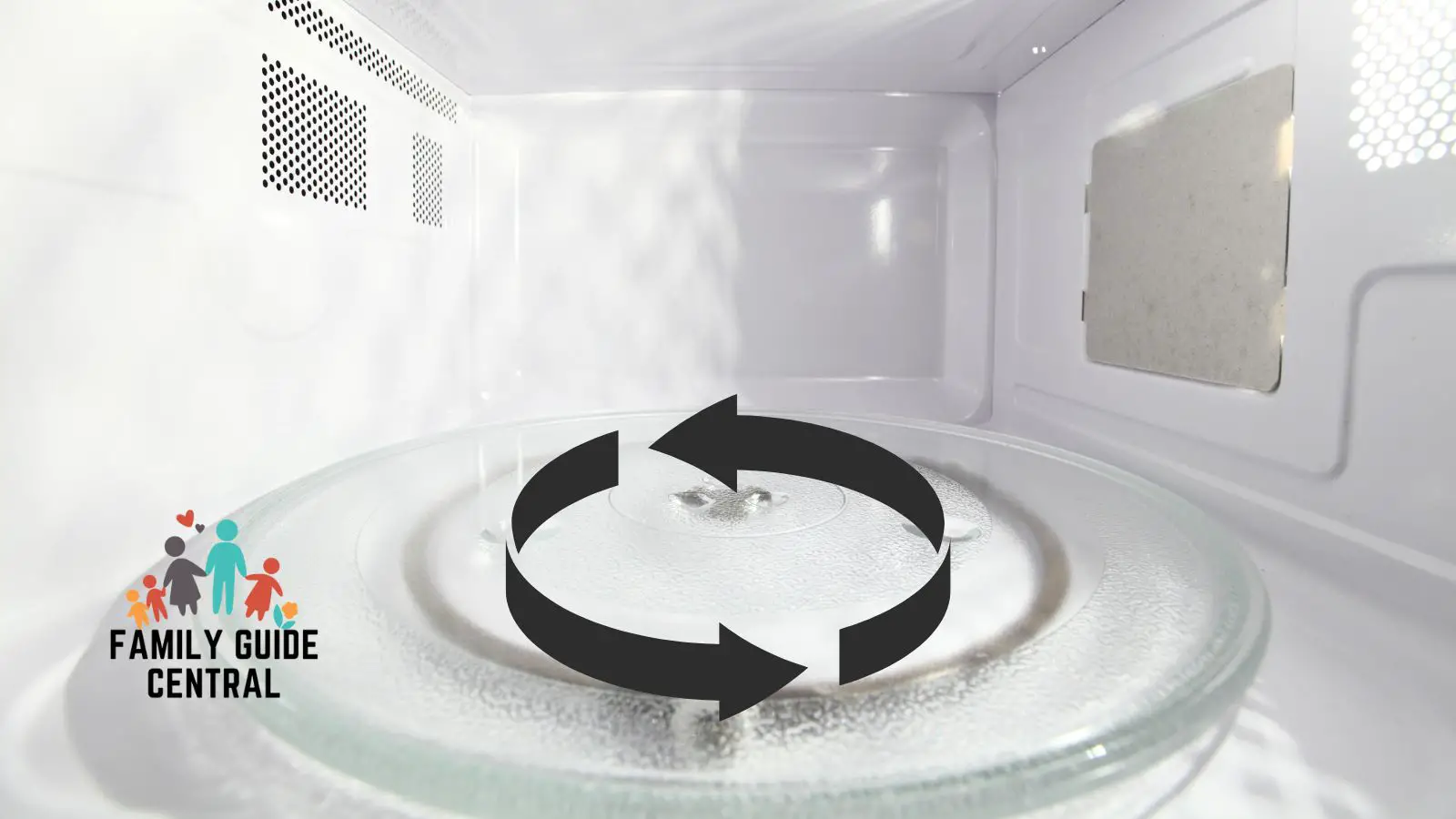Why Does a Microwave Spin? (And Why It’s a Safety Concern if it Doesn’t)
You know what’s annoying? When your microwave doesn’t spin.
In this article, we’ll be talking about why microwaves spin in the first place and why it’s important that they do.
Why does a microwave spin?
Inside the chamber of a microwave, there are static areas with standing columns of energy waves. These waves move so quickly that they collide head-on, creating intense heat that cooks in the same area and never moves. Engineers came up with the idea to design microwaves with a rotating plate in order to help spin food and move it to these standing columns to cook evenly under these wave areas.
Spinning the food you place inside will help evenly distribute the heat throughout the food. This will provide a quick hot meal.
However, it’s not a perfect solution. The rotation of the meal often heavily cooks the area closest to the center of the microwave. It’s still a better solution than letting it stand still in a microwave to only cook one area of the food.
What are microwaves?
Microwaves are waves that can be found on the standard electromagnetic spectrum. It’s sandwiched between radio waves and infrared waves.
Essentially, microwaves have a frequency of approximately 2,450 megahertz. These waves have interesting properties at this level because they are attracted to water. Water absorbs microwaves and almost immediately converts to heat and evaporates.
Another interesting point to add is that these waves seem uninterested in most plastics, glass, or ceramics. Thus, you often hear the microwave-safe label on most of these items.
However, microwaves are reflected violently by metal. So don’t place items like forks, spoons and aluminum, foil in your microwave. It will certainly create sparks and even cause an explosion.,
Why does a microwave need a rotating plate?
To better explain why a rotating plate is necessary, it’s best to understand exactly how microwaves cook food.
Within a typical microwave, there’s an object called a magnetron. This magnetron creates microwaves. The magnetron floods the microwave chamber with these microwaves. When a pair of microwaves of the save wavelength end up colliding, they exhibit heat. When a lot of these waves bounce off each other, it forms a new wave known as a standing wave.
With the sheer number of these occurrences happening all at once, the chamber of the microwave begins to contain fixed areas of standing waves.
By some chance, if your food is right there at the point of when the standing waves occur, then your food gets cooked specifically by these standing waves.
Engineers of the microwave have come up with a clever idea of continuously rotating the food using a plate, to give your food a better chance of this heating event occurring.
What are the signs that a microwave is going bad?
If you’re wondering if it’s time to replace that microwave, I’ve got a few tips for you. Electronic devices don’t last forever. When they get to a certain age, you might have to consider replacing them.
Generally speaking, if your rotating plate isn’t working, it doesn’t necessarily mean the microwave needs replacing. There are perhaps ways to fix this issue.
However, there are other signs you might be interested to know that could be a major issue.
A few of the reasons why you should be concerned about your microwave are listed below.
- Smoke, sparks, and burning smell: This may end up being a serious issue. Do not continue using the microwave. Turn it off and unplug it. You should refrain from using it again out of the possible danger of fire or explosion. This is when you should consider buying a new one.
- Food is not cooking: If the microwave doesn’t seem to be able to warm up or even boil water, then it might be time to get a new one. This issue oftentimes is due to age and by a certain age, even microwaves begin to have these issues.
- Making loud sounds: Microwaves are often really quiet. But when start to heard loud grinding and rattling noises, something might be wrong. I’ve had this issue in the past. The sound could come from anywhere, even the rotating table. Check that first. There are a number of other issues like if you hear a loud buzzing noise, that could be the magnetron. A rattling noise might be the fan. There’s also a stirrer motor above the chamber.
- The door doesn’t seal properly: This is a major issue because the door is the one thing stopping the radiation from getting to you. This type of radiation can cause serious harm to humans and animals. Repairing the door by replacing whatever parts are needed to fully and securely seal it.
- The keypad doesn’t work: This is probably the most annoying and most frequent occurrence out of all the issues listed. When the keys no longer work, it almost seems comical. A perfectly good working microwave and no way to press for 1 minute, instead you have to punch in 60 seconds or even 2 minutes and wait to manually shut it off. This might not be a good reason for replacement, but repairing it isn’t out of the question
- It’s over 10 years old: Microwaves last a long time. I have a 10-year-old microwave myself and it’s still doing great minus the 1 button. But if anything else were to fail on this machine, since it’s 10, I would strongly lean towards replacing it.
What are the risks of a microwave not turning on?
- Uneven cooking creating hot spots: The turntable in a microwave helps to ensure even cooking by rotating the food and distributing the microwaves evenly. If the turntable is not turning, there is a risk of hot spots developing in the food. Hot spots occur when certain areas of the food receive more microwaves than others, resulting in uneven cooking and potentially dangerous temperatures.
- Creating cold spots: Similarly, if the turntable is not turning, there is a risk of cold spots developing in the food. Cold spots occur when certain areas of the food do not receive enough microwaves to cook properly, resulting in undercooked food that can lead to foodborne illnesses.
- Risk of explosion: If the turntable is not turning, there is also a risk of explosion. This is because microwaves work by creating electromagnetic radiation that heats up the water molecules in the food. When the water molecules get too hot, they can create steam, which can cause an explosion if it has nowhere to escape. If the turntable is not rotating, steam can build up in certain areas of the food, increasing the risk of an explosion.
- Risk of burns: When the turntable is not turning, it can be difficult to remove hot items from the microwave safely. This can increase the risk of burns from touching hot surfaces or spilling hot liquids.
- Problems with cooking certain items like liquids: Another safety concern when a microwave is not turning is problems with cooking certain foods like liquids. When liquids are heated in a microwave without a rotating turntable, they can become superheated, meaning that they reach temperatures higher than their boiling point without boiling. Superheated liquids can be dangerous because they can explode when disturbed, such as when a spoon or other object is placed into the liquid. This can result in serious burns and other injuries.
- Risk of bacteria growth: Finally, if the turntable is not turning, there is a risk of bacteria growth in the food. Bacteria can grow quickly in warm, moist environments, and undercooked food can be a breeding ground for harmful bacteria. If the food is not cooked evenly, some areas may not reach the necessary temperature to kill off bacteria, increasing the risk of food poisoning.
How do you fix a microwave spinner?

- Unplug your microwave.
- Remove the roller tray.
- Remove the roller guide.
- Remove the drive coupler.
- Flip the microwave over on its back to access the bottom of it.
- Remove all the bottom panel screws.
- Remove the wires from the drive motor.
- Replace the drive motor with a new one.
- Reassemble the bottom panel and screw it back on.
- Turn the microwave to standing up.
- Place the drive couplers, then roller guide, then roller tray back on.
- Test the microwave for spinning and heating.
Is it dangerous if your microwave doesn’t spin?
Generally speaking, no. Microwaves that no longer have functioning spinners or drive motors shouldn’t cause any harm directly to humans. The rotation of the food doesn’t benefit or defer the microwave itself in any way.

However, it’s specifically used to evenly cook food which should be checked carefully for uncooked areas of food. The reason for the spinning of a plate in the microwave is to make sure your food is cooked evenly throughout. If you happen to accidentally eat parts of food that were uncooked and cold, you might end up with some illnesses.
A spinning tray no longer working or malfunctioning is extremely common. More often than not, the owner would just use the microwave without worrying too much about the spinning. These people would usually put their food into the microwave at different angles and microwave it more than once.
Failure of the drive motor will not have much effect on the longevity or safety of the microwave itself. The microwave will work just fine for years to come.
The differences between a turntable microwave and a flatbed microwave?
The main difference between a turntable microwave and a flatbed microwave is in their design and functionality.
A turntable microwave features a rotating turntable in the center of the cooking cavity. This turntable spins while the food is cooking to make sure that the microwaves reach all parts of the food and cook it evenly. Turntable microwaves are more common and widely used.
A flatbed microwave, on the other hand, does not have a rotating turntable. Instead, it uses a different technology, such as rotating reflectors or a waveguide, to distribute the microwaves evenly across the food. This lets larger or oddly shaped dishes fit inside the microwave without a turntable getting in the way.
Other differences between turntable and flatbed microwaves include:
- Capacity: Flatbed microwaves often have a larger capacity than turntable microwaves because they don’t have the space constraints of a turntable.
- Cleaning: Turntable microwaves can be more difficult to clean because the turntable and the support wheels can collect food debris and grease. Flatbed microwaves, on the other hand, have a flat surface that is easier to wipe clean.
- Cooking performance: Flatbed microwaves are designed to cook food evenly without the need for a turntable, which can result in more evenly cooked food. However, some users may prefer the more traditional turntable microwave because they are used to the way it cooks their food.
Is there ever a time when your microwave shouldn’t rotate?
The primary reason for disabling the turntable in a microwave is to accommodate larger or irregularly shaped dishes that can’t turn in your microwave.
It is recommended to transfer food into a smaller dish to accommodate the turntable, because if you don’t, it can result in uneven cooking or hot spots if the dish is too big for the microwave.
Can you still use a microwave that isn’t spinning?
Yes, you can still use a microwave that isn’t spinning, but there may be some limitations and safety concerns to consider.
If you need to use a microwave without a spinning turntable, you should take extra care to stir or rotate the food frequently during cooking to promote even heating.
You may also need to change the cooking time and temperature to make up for the fact that the food isn’t turning and make sure it’s cooked all the way through.
It is important to note that if the turntable isn’t spinning because of a mechanical issue or malfunction, you should avoid using the microwave until it has been repaired or replaced to prevent potential safety hazards.
How do some microwaves not spin?
Traditional microwaves have had an evolution at some point in its era. While the majority of all microwaves today are still using the usual turntable microwave, a new microwave was introduced.
It’s called the flatbed microwave. Flatbed microwaves don’t need the turntable to evenly cook food. In fact, flatbed microwave machines have a magnetron that rotates underneath the microwave and cooks the food evenly.
Does it matter what direction the turntable spins in?
The type of motor used to turn the turntable can indeed impact whether it reverses direction or not, and some models may always rotate in the same direction.
While reversing the direction of rotation can promote even wear and tear on the motor and prolong the life of the microwave, it may not have a significant impact on cooking performance.
Why does the microwave turntable turn when the door is open?
The microwave turntable should not turn when the door is open. In fact, modern microwaves are made with safety features that prevent the turntable from turning when the door is open. This is to keep people from getting hurt or having accidents.
If your microwave turntable is turning with the door open, it may be a malfunction or defect that needs to be addressed immediately.
Turning off and unplugging the microwave and contacting a qualified technician or the manufacturer for assistance is recommend.
Are flatbed microwaves better than rotating microwaves?
If you are wondering if flatbed microwaves are better than turntable microwaves, you are right. Flatbed microwaves cook even more evenly, don’t require a turntable piece, they are often larger, and easy to clean compared to turntable ones.
So what do you get from buying a flatbed microwave? You get a more evenly spread of heat and cooking when using a flatbed microwave.
Having the magnetron and antenna itself rotate now creates more dynamic “moving” waves that bounce around the chambers of the microwave. The waves are ricocheting off each other at slightly different angles compared to the traditional turntable microwave. this ends up providing a lot of random and variability and where the microwave heats.
Furthermore, it eliminates the need for the food to rotate.
Studies and experiences with these types of microwaves have found to be much more beneficial and efficient compared to other microwaves. Allowing a thorough cook evenly distributed throughout the food. It simply helps prevent reheating of food due to non-cooked spots when using a turntable microwave.
A final benefit with flatbed microwaves is that due to not requiring a turntable, the chamber can be much larger to hold more things.
And since there’s really nothing moving inside these microwaves, you get the added benefit of easy-to-clean machines.
Other interesting articles:
- Do Keurigs Get Moldy? (The Best Way to Clean Your Coffee Maker)
- Can Rice Cookers Catch Fire and Explode? (Pro Tips on Prevention and Putting Out the Fire)
- How to Easily Protect Your Floors from Dining Table Legs (5 Do’s and 1 Don’t)
- The Best Shape Dining Table for Parties and Large Families (Calculations and Proof!)
